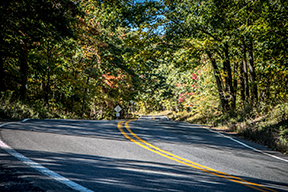Staying on designated trails protects trailside plants, prevents erosion and respects private property.
- Camp only on existing or designated campsites to avoid damaging plants. Protect sensitive areas alongside water by camping at least 200 feet from lakes, rivers and streams.
- When camping in a campground at a State Park, State Forest or National Forest, research the type of camping experience the area offers and reserve a spot that will meet your group’s needs. While some campgrounds may be more developed with restrooms and electric hookups, others may only offer more primitive sites. When camping outside of developed campgrounds, ensure ample time to locate an appropriate site and have a backup plan.
- When traveling by motorized vehicle, be sure to use existing roads and trails that are intended for the type of vehicle you are using. Some rural roads are gravel and may have weight restrictions.
©Leave No Trace: www.LNT.org.

EXPLORE MORE
< GO BACK TO THE LEAVE NO TRACE MAIN PAGE

